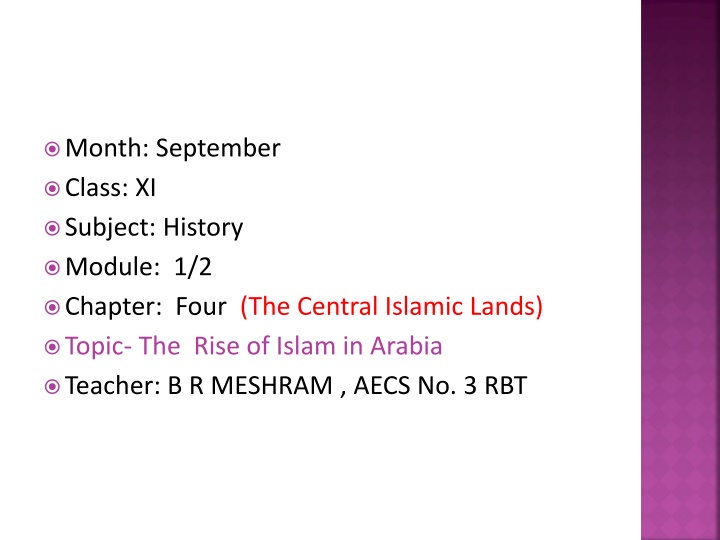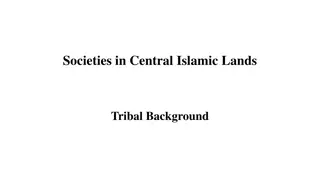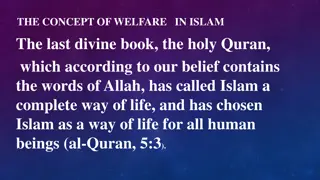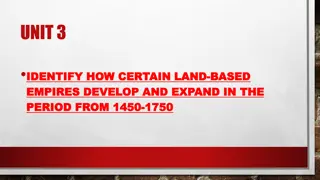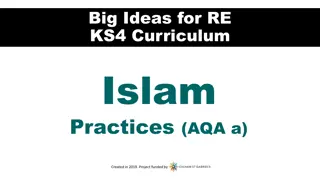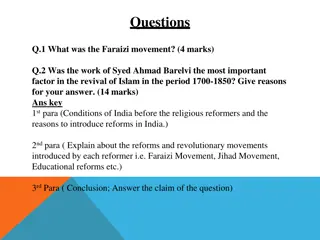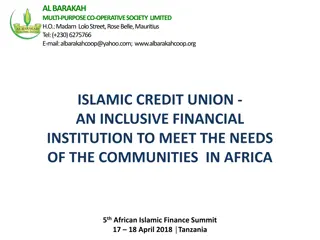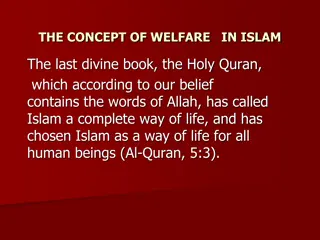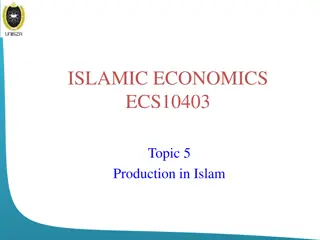The Rise of Islam in Arabia: Understanding Islamic Empires and Culture
Explore the origins and development of the Islamic community in the Arabian Peninsula, spanning from 600 to 1200 AD. Learn about the rise of Islamic empires in Afro-Asian territories, the impact of the Crusades, and the evolution of faith, politics, and society. Delve into key concepts such as the Caliphate, Umayyad rule, Abbasid Revolution, and the economy of the Central Islamic lands.
Download Presentation

Please find below an Image/Link to download the presentation.
The content on the website is provided AS IS for your information and personal use only. It may not be sold, licensed, or shared on other websites without obtaining consent from the author.If you encounter any issues during the download, it is possible that the publisher has removed the file from their server.
You are allowed to download the files provided on this website for personal or commercial use, subject to the condition that they are used lawfully. All files are the property of their respective owners.
The content on the website is provided AS IS for your information and personal use only. It may not be sold, licensed, or shared on other websites without obtaining consent from the author.
E N D
Presentation Transcript
Month: September Class: XI Subject: History Module: 1/2 Chapter: Four (The Central Islamic Lands) Topic- The Rise of Islam in Arabia Teacher: B R MESHRAM , AECS No. 3 RBT
OBJECTIVE- Familiarize the learner with the rise of Islamic empires in the Afro-Asian territories and its implications for economy and society. Understand what the crusades meant in these regions and how they were experience
INTRODUCTION- Muslims people living in all parts of the world. They are citizen of different nation, speak different languages, and dress differently. The Islamic community has its roots in more unified past which roughly 1400 years ago in Arabian Peninsula. Our understanding of the history of the central Islamic lands between 600 and 1200 is based on the chronicles. The term Islamic is used here not only in its purely religious sense but also for the overall society and the culture historically associated with Islam.
CONCEPTS: 1. Rise of Islam in Arabia Faith , community and politics 2. The Caliphate : Expansion , civil wars and Sects Formation 3. The Umayyad and the centralization of polity 4. Abbasid Revolution 5. Break up of Caliphate and Rise of Sultanate 6. The Crusades 7. Economy : Agriculture, Urbanization and Commerce 8. Learning and culture
RISE OF ISLAM IN ARABIA- A) FAITH : Polytheistic Arabs : The Arabs divided into Qabilas each led by a chief . Each tribe had its own god or goddess, who was worshipped as an idol (sanam) in a shrine (masjid). Many Arab tribes were Nomedic moving from one place to another place in search of food. The Arab tribes were made up of clans or combination of large families. Muhammad belongs to the tribe known as Quraysh.
PROPHET MUHAMMAD: He was born in Mecca in 570 in present day Saudi Arabia. During 612-32, the Prophet Muhammad preached the worship of a single God, Allah. He also preached to take membership of a single community of believers i.e. Umma This was the origin of Islam. Around 612, Muhammad declared himself to be the messenger (rasul) of God who had been commanded to preach that Allah alone should be worshipped. The Arabian culture of sixth century was mainly confined to the Arabian peninsula , Southern Syria and areas of Mesopotamia.
HIJRA- Those who accepted the doctrine of Muhammad came to known as Muslims. Due to opposition from the prosperous people of Mecca, Prophet Muhammad was forced to migrate with his followers to Medina in 622 CE is called Hijra. Muhammad s journey from Mecca to Medina was a turning point in the history of Islam, with the year of his arrival in Medina marking the beginning of the Muslim calendar.
(B) COMMUNITY Muhammad created a political order from all the three sources which give his followers the protection they needed as well as resolve the city war. Muhammad was to found a community of believers (umma) bound by a common set of religious beliefs. The community would bear witness (shahada) to the existence of the religion before God as well as before members of other religious communities They were promised salvation on the Day of Judgment (qiyamat) and a share of the resources of the community while on earth. The Muslims soon faced considerable opposition from affluent Meccans who took offence to the rejection of their deities and found the new religion a threat to the status and prosperity of Mecca.
KAABA- After Muhammad took the city of Makkah he cleaned the kabba of ideals and dedicated it to Allah, who he taught was the one true God.
THE FIVE PILLARS OF ISLAM- Declaration of faith- Muslim must state that there is one god Allah and Muhammad is prophet Daily prayer- Muslims must pray five times a day facing the kaaba in Mecca. Charity- Muslims are supposed to help others and donate part of their income to charity(Zakat) Fasting-Ramadan Muslims must fast from sunrise to sunset during the holy month of Ramadan. Pilgrimage to Mecca- the fifth pillar of Islam is Haji. Once in lifetime if they are physically and financially able , Muslims are to journey to Mecca and performs the rituals of the Haji.
(C) POLITY After Muhammad s death in 632 AD political authority was transferred to the Umma with no established principle of succession. This created opportunities for innovations but also caused deep divisions among the Muslims. The biggest innovation was the creation of the institution of caliphate, in which the leader of the community (amir al-muminin) became the deputy (khalifa) of the Prophet.
THE CALIPHATE: EXPANSION The twin objectives of the caliphate were to retain control over the tribes constituting the umma and to raise resources for the state. The main duties of the Khalifas were to safeguard and spread Islam. The first four caliphs justified their powers on the basis of the close relation with the prophet Muhammad and continued his work under the general guidelines he had provided.
FOUR CALIPHS- The first Caliph Abu Bakr, launched a number of campaigns to suppress the revolts. The second caliph Umar adopted the policy of expansion of the power of Umma. The third Caliph, Uthman launched further campaigns to gain control over central Asia. The fourth caliph fought two wars against the people representing the aristocracy of Mecca. During the reign of Caliph Ali, Islam was divided into two sects namely Shias and Sunnis.
THE UMAYYAD AND THE CENTRALIZATION OF POLITY: The Umayyad dynasty was founded by Muawiya in 661 CE . The Umayyad implemented a series of political measures which consolidated their leadership within the Umma. He also introduced hereditary succession and persuaded the leading Muslims to accept his son as his heir. This dynasty lasted till 750 CE. In 750 CE , the Umayyad dynasty was replaced by the Abbasids.
THE ABBASID REVOLUTION- The Umayyad dynasty had to pay a heavy price for their success in centralizing the Muslim polity. The Abbasid revolution was a well organized movement called Dawa., launched by the Abbasid to the end the rule of Umayyad dynasty. The Abbasids were descendents of Abbas, uncle of Prophet Muhammad. The Abbasid s called the Umayyad regime as evil and claimed that they will restore the original Islam of the prophet.
MAIN FEATURES OF ABBASID REVOLUTION: Arab influence declined under the Abbasid rule. On the contrary to it, importance of Iranian culture increased. The Abbasid established their capital at Baghdad. The Abbasid reorganized their army and bureaucracy on non tribal basis. It ensured the more participation of Iraq and Khurasan. The religious status and functions of the Caliphate were strengthened by the Abbasid rulers.
ABBASID REVOLUTION AND MONARCHY- No, Abbasid rulers were not able to abolish monarchy. Needs of government and empire to force them to retain the centralized nature of state. They not only maintained the magnificent imperial architecture and elaborate court ceremonials of Umayyad.
ASSIGNMENT- Who was prophet Muhammad? Who was the founder of Islam? What was kaba? When did Prophet Muhammad declare himself to be messenger of god? What is meant by the term Abbasid revolution ? Name the two main sects of Muslims. Name the first and second Khalifa of Muslims.
